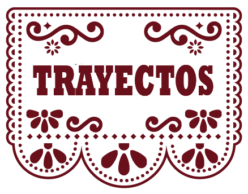Main Content
Trayectos consists of thematic modules. Each of them combines existing OER and novel materials. In each module, we have included the following sections:
1. Objetivos (Objectives): Each module is introduced by an objectives section in which we give learners information about the instructional goals we have set for their learning in terms of language use (Comunicación), grammatical and vocabulary knowledge (Lengua), and culture (Cultura). We also ask students to record what they want accomplish in personal terms. We call it Mis metas (My Goals).
2. Introducción comunicativa (Communicative Introduction): In this section, we introduce, in context, the vocabulary and grammatical structures on which the module will focus. Here we draw learners’ attention to the message that is conveyed and the language used in order to do so.
3. Hablemos más (Let’s talk a bit more): In this section, we provide students with more vocabulary that they can use in their communication.
4. Manos a la obra (Let’s Do It): These sections appear throughout each module, and they provide learners with multiple opportunities to actively use their new vocabulary and structures. The activities in Manos a la obra allow students to work collaboratively with their classmates, and to use Spanish to communicate in different modes–interpersonal (speaking); interpretive (reading/listening); and presentational (writing/oral presentations with multimodal elements).
5. Trayectos hispanos: The purpose of these sections is to highlight different aspects (e.g., people, places, art, activism, etc.) of the Hispanic/Latinx communities in the United States through thematic readings and/or videos and images and tasks that will allow students to know more about the unique ways in which members of these groups have contributed to the country.
6. Hablemos de gramática (Let’s Talk About Grammar): In this section, we present the rules guiding the grammatical structures included in the module. Through contextualized examples, we guide students’ learning by tying the forms presented to the meaning they convey.
7. Hablemos de cultura (Let’s Talk About Culture): This section focuses on cultural aspects of different countries in the Spanish-speaking world. Culture is presented through thematic readings, videos, and images and critical thinking tasks that allow learners to reflect on the target culture and their own.
8. Más comunicación (More Communication): This section focuses on functional language–the structures and vocabulary that are used in specific social contexts (e.g., ordering a meal, buying a ticket to see a movie, etc.). Here we draw learners’ attention to the message that is conveyed and the language used in order to do so.
9. Conversemos (Let’s Talk): This section offers opportunities to use Spanish in conversation (interpersonal mode of communication).
10. Cartelera (Billboard): This section introduces students to short films developed in the Spanish-speaking world. Learners will watch the chosen productions, and they will work individually and collaboratively with a variety of comprehension and interpretation tasks.
11. Lectura (Reading Comprehension): This section offers learners the opportunity to read a variety of texts written by different authors in the Spanish-speaking world. Students will read the chosen texts, and they will work individually and collaboratively with a variety of comprehension and interpretation tasks.
12. Proyecto digital (Digital Project): The objective of the digital project is to provide students with the opportunity to apply the Spanish they have learned to create a personal profile in Spanish to introduce themselves and aspects of their life to Spanish speakers. In each module, learners will develop different parts of this project applying the specific vocabulary and structures they have learned in it.
13. Antes de partir (Before We Go): In this final section, we revisit the contents of each module, the goals we set for students at the beginning of the chapter, and the personal aims they wanted to accomplish. Our hope is that this section will offer learners the chance to reflect on their learning process and to set new objectives for the next step in your growth as a Spanish speaker.
Supplementary Resources
Práctica individual (Individual Practice): At the end of most sections in each module in both volumes of Trayectos, we offer links to activities that provide learners with more opportunities to use the language learned. These exercises are self-correcting, and can be completed individually.
Voces de nuestro mundo: This section consists of self-standing units based on multimodal ensembles that connect learners to authentic texts through different semiotic modalities (e.g., audio, visual, textual, etc.). However, the language and themes are connected to those in Trayectos. The main objective of these units is to provide students with the opportunity to use Spanish to learn more about socially-relevant issues related to diversity, equity, and inclusion in the Spanish-speaking world. Even though the activities in Voces de nuestro mundo can be adapted to cater to a variety of proficiency levels, they have been developed for novice-high/intermediate-low students. The units or some of the tasks in them can also be used as summative assessment tools (e.g., project-based learning, portfolio-based assessment).
El mundo tejano (The Texan World): The purpose of these sections is to highlight different aspects (e.g., people, places, art, etc.) of Hispanic Texas through thematic readings and/or videos and images and tasks that will allow students to know more about the unique ways in which members of Texas’ Hispanic/Latinx communities have contributed to the state. We recommend this section for instructors teaching in Texas.

